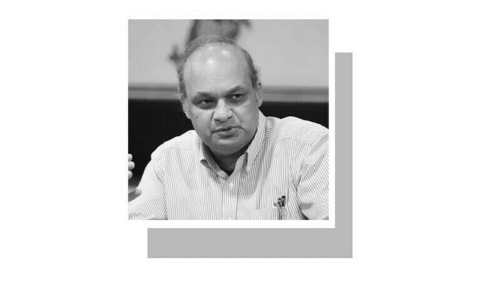Sadequain was known for an energetic, enigmatic and rebellious personality and also for his urge to express his ideals and philosophies through his lines, textures and symbols, which defined his unique painting style.
His art and personality are complementary to each other; his works a mirror to his multidimensional, deep, mysterious and dramatic nature which, in reference with social norms and values, seems bohemian. Sadequain as an artist, within his domain of intentional and unintentional imagination, has always remained unparalleled.
Exaggeration, horror, metamorphosis, drama, mythology, history and identity are his favourite areas that he experimented with through his art where the characters that he has presented are somehow psychological reflections of his own personality.
Thirty years after his death, we look back at the life and legacy of Pakistan’s greatest artist
He likes to live in the ancient civilisations, follows various religions and mythologies through time, regardless of geographical boundaries and ethnic constraints. His characters emerge from Greek or Hindu mythos, or variously embrace martyrdom in the lands of Baghdad following the spiritual reincarnation of Sarmad, Mansoor and Hazrat Imam Husain.

The Sar-ba-Kaf (head on hand or headless) series exhibits this unique, deep and reflective area of his persona. Then he finds himself as a disciple of great philosophers and thinkers when he personifies Aristotle, Socrates and Ibn-i-Khaldun or takes on the avatars of the scientists of the Muslim golden era like Ibn-i Haisam, Al-Khwarazami and Ibn-i-Sina to thinkers of the modern period of the 20th century; Albert Einstein or Karl Marx.
The artist’s interest in history, philosophy and poetry made him a thematic painter but at the same time, his love and admiration for the darker side of life overwhelmed the subtle, aromatic or beautiful aspects.
Sadequain fell in love with the mystic concept of Malamat (grotesque), where the Sufis, by rejecting the accepted law, try to explore a personal relationship with the Almighty.
Akbar Naqvi in his book Image and Identity comments on this aspect as: “Sadequain’s art enacted the drama of malamat in its Zahiri (external) and Batini (internal) aspects — the coincidence and confusion of appearance and reality as awareness of truth in the definition of the self.”
Much has been written and assumed about the personality of Sadequain; for some, he is a mystic Sufi and for others, he is a drunken schizophrenic. However, in all the elaborated contexts, he has been labelled as the “Holy Sinner” and accepted as a prolific and skilled artist.
Sadequain was considered as a living paradox of placid personality and a narcissistic, rebellious creator of his craft
The system of symbols that Sadequain implied in his art can provide a retrospective linkage to his time, ideals, thoughts and psychological status. For instance, the sun, cactus, crow or the scarecrow, crucifixion and headlessness reflect the painter’s identity in a symbolic, and at times, in a metaphorical approach.
Iftikhar Dadi in his book Modernism and the Art of Muslim South Asia described the sources of his inspirations as: “Upon his beheading in 1661, Sarmad’s extraordinary spiritual power exhibited itself when the headless body began walking, carrying its severed head in its hands, until other Sufis begged the decapitated Sarmad to refrain from openly displaying such power.
“Sadequain’s subjectivity is enacted in these drawings via complex condensation of references to the transgressive subjectivity embodied by Sarmad, along with the mythos of Picasso, and, as Vazira Fazila-Yacoobali Zamindar has observed, might also have been charged by the release of feature films glorifying artistic genius — Van Gogh in the film Lust for Life (1956) and Michelangelo in The Agony and The Ecstasy (1965).”
In this context, Sadequain’s personality appears as a split personality which, however, has the extraordinary ability to adhere and unite all the ordinary fragments that form an interesting, tempting and fascinating image; not only in his paintings but also within his individuality.
The maestro had always been deeply involved in poetry and written numerous Rubaiyat (quadrants); a poetic form consisting of four verses. This attitude compelled his mind to transform the literary imagery of Ghalib, Iqbal and Faiz and Albert Camus into a visual dictum based on similes and metaphors. However, in this process, he never neglected his own existence in this process of transition from a reader to a thinker to a painter. This ability enabled him to survive as an artist in the times of ‘Islamic socialism’ in the ’70s and then the ‘Islamisation’ of Zia during the early ’80s when he turned to Quranic calligraphy and laid the foundation of modern calligraphy in Pakistan.
Was Sadequain a romanticist, an expressionist, an exhibitionist or a narcissist? Certainly, if we use his work to garner clues about his personality (and vice versa) such traits do emerge. However, the elements like horror, hyperbole and exaggerated theatricality can force one to call him a baroque painter. In all these angles, one gets confused about the multifarious personality of Sadequain, who at times appears a restless soul travelling through time, wandering around the remains of history, spellbound by the mythologies and following the footsteps of the religious saints or, at times, sitting submissively in supplication to the mesmerising beauty of nature.
Dark themes, a trained consciousness and an obsession for self-identity; these essentials in a chaotic yet synchronised rendering made Sadequain the black onyx among the other gems of Pakistani art.
An earlier version of this story appeared in Dawn, Sunday Magazine, February 8th, 2015













































